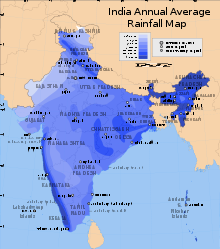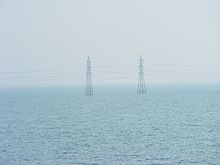- Climate of Bihar
-
Contents
History
Seasons
Winter
The cold weather commences early in November and comes to an end in the middle of March.[1]The climate in the cold weather is pleasant. The days are bright and warm and the sun is not too hot. As soon as the sun sets the temperature falls and the heat of the day yields place to a sharp bracing cold. The mean temperature in November all over Bihar varies from 5 C to 10 C.[1] The mean temperature in Gaya and Patna in December is 10 C and 18 C respectively. January is the coldest month in Bihar.
Summer
The hot weather sets in and lasts until the middle of June. The highest temperature is often registered in May which is the hottest month in the state. Like the rest of the northern India, Bihar also experiences dust-storms, thunder-storms and dust raising winds during the hot season. Dust storms having a velocity of 48–64 km/Hour are most frequent in May and with second maximum in April and June. The hot winds (loo) of Bihar plains blow during April and May with an average velocity of 8–16 km/hour. This hot winds greatly affects human comfort during this season.
Monsoon
Soon after Mid June this the rainy season commences and continues till the end of September,[2] the beginning of this season occurs when a storm from the Bay of Bengal passes over Bihar. The commencement of monsoon may be as early as the last week of May or as the first or second week of July.The rainy season begins in June. The rainiest months are July and August. The rains are the gifts of the south west monsoon. There are in Bihar three distinct areas where rainfall exceeds 1800mm. Two of them lie on northern and north-western wings of the state and the third lies in the Netarhat pat. The south-west monsoon normally withdraws from Bihar in the first week of October.
Post Monsoon
An important feature of the retreating monsoon season in Bihar is the invasion of tropical cyclones originating in the Bay of Bengal at about 12 N latitude. Bihar is also influenced by the typhoons originating in the south China sea. The maximum frequency of the tropical cyclones in Bihar is during September-November[2] especially during the asterism called hathiya. These cyclones are essential for the maturing of paddy, and are required for the moistening of the soil for the cultivation of rabi crops.
Statistics
Temperature
Average temperatures in various cities of Bihar (°C)[3][4][5][6] — Winter
(Jan – Feb)Summer
(Mar – May)Monsoon
(Jun – Sep)Post-monsoon
(Oct – Dec)Year-round City Jan Feb Mar Apr May Jun Jul Aug Sep Oct Nov Dec Avg Patna 16 19 25 30 31 31 29 15 28 26 22 17 26 Arrah 16 18 24 30 31 30 29 28 29 26 21 17 25 Darbhanga 16 18 23 28 29 29 29 28 28 26 21 17 25 Precipitation
Average precipitation in various cities of Bihar (mm)[3][4][5][6] — Winter
(Jan – Feb)Summer
(Mar – May)Monsoon
(Jun – Sep)Post-monsoon
(Oct – Dec)Year-round City Jan Feb Mar Apr May Jun Jul Aug Sep Oct Nov Dec Total Patna 10 --- 10 --- 40 120 220 260 170 70 10 --- 990 Arrah 10 10 10 --- 30 180 290 330 210 50 --- --- 1180 Darbhanga 10 10 10 10 60 190 300 340 230 50 --- --- 1260 Disasters
Floods
A view of 2008 Bihar flood Main article: Floods in BiharSee also: 2008 Bihar flood, 2007 Bihar flood, and Gautam Goswami
Main article: Floods in BiharSee also: 2008 Bihar flood, 2007 Bihar flood, and Gautam Goswami“ Total human deaths is 5874 and animal deaths is 19044 in Bihar due to floods between 1979–2006[7][8] ” Bihar is India's most flood-prone State, with 76% of the population in the north Bihar living under the recurring threat of flood devastation.[9] According to some historical data, 16.5% of the total flood affected area in India is located in Bihar while 22.1% of the flood affected population in India lives in Bihar.[10] About 68,800 square kilometres (26,600 sq mi) out of total geographical area of 94,160 square kilometres (36,360 sq mi) comprising 73.06% is flood affected. Floods in Bihar are a recurring disaster which on an annual basis destroys thousands of human lives apart from livestock and assets worth millions.[9]
Earthquakes
See also: 1934 Bihar earthquakeuytguyDrought & Famine
Pollution
See also
- Climate of India
- Climatic regions of India
- Geography of Bihar
References
- ^ a b http://www.biharonline.in/Profile/Geography/climate.asp
- ^ a b http://gov.bih.nic.in/profile/climate.htm
- ^ a b "Country Guide: India". BBC Weather. http://www.bbc.co.uk/weather/world/country_guides/results.shtml?tt=TT002240. Retrieved 2007-03-23.
- ^ a b "Weatherbase". Weatherbase. http://www.weatherbase.com. Retrieved 2007-03-24.
- ^ a b "Wunderground". Weather Underground. http://www.wunderground.com. Retrieved 2007-03-24.
- ^ a b "Weather.com". The Weather Channel. http://www.weather.com. Retrieved 2007-03-23.
- ^ Disaster Management in Bihar
- ^ Disaster Management in Bihar - Statistics
- ^ a b Flood Management Information System - History of Flood in Bihar
- ^ India Water Portal - Bihar Floods 2008
Categories:
Wikimedia Foundation. 2010.


